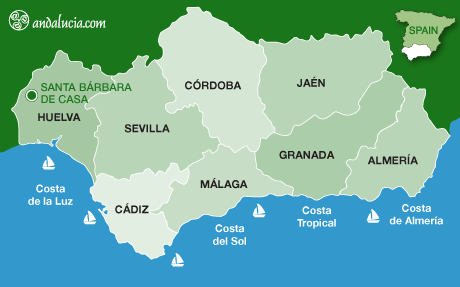Santa Bárbara de Casa
by Saskia Mier
Santa Bárbara de Casa is situated very north of El Andevalo and has a large surface area covering 144km². It has 1093 inhabitants.
HISTORY
From the dolmens of "La Zarcita" and its history there is very little data about the history. It is however known that the inhabitants of Santa Bárbara de Casa were fearless and decided to inhabit the once border to Portugal, which lacked security.
During the Moorish ruling, Santa Bárbara de Casa was under ruling of Cora de Niebla and it was not until the Christian conquest when the first documentary sources bout Santa Bárbara de Casa appear.
The repopulation of hamlets such as Los Palacios, La Fuentecubierta and El Hornillo allowed the initial Santa Bárbara de Casa to be formed in a new location, at the foot of the Ermita de Santa Bárbara and along the stream called Casa.Thus creating Santa Bárbara de Casa.
THINGS TO SEE
Dólmenes de "La Zarcita"
The archaeological sites of "La Zarcita", also known as Cabezo de los Vientos, dates back to the Chalcolithic period of the fourth century and the third Millennium B.C.A settlement as well as a necropolis have been discovered. Located in a strategically chosen place for its visibility and proximity to rich agricultural land "La Raña". The archaeological remains can be seen in the Museo Provincial de Huelva (museum).Located south west of Santa Bárbara de Casa, off the HV-7017.
Molinos harineros de agua y de viento
The windmills are located in the nearby hills to Santa Bárbara de Casa and were placed there to take advantage of incoming Atlantic winds. Hydraulic or watermills are located in the valley of the stream Casa.
Ermita de Santa Bárbara
According to studies by historian, Felix Sancha Soria, the Ermita de Santa Bárbara was built by the first inhabitants established in nearby villages like El Hornillo and Los Palacios in the early sixteenth century. These first settlers needed to establish a spiritual refuge on a nearby hill and therefore built the chapel with the village at its feet. Located on Calle Santa.
Iglesia de Nuestra Señora de la Piedad
The Iglesia de Nuestra Señora de la Piedad dates back to the last third of the eighteenth century, built between 1769 and 1776 by Ambrosio de Figueroa. Located on Plaza Resolana.
Ermita de San Sebastián
A relatively new build, the chapel was built to celebrate the pilgrimage in honour of the patron of Santa Bárbara de Casa, San Sebastián. Located on the outskirts of the village.
Hotels near Santa Bárbara de Casa
Book Hotels near Santa Bárbara de Casa
COUNTRYSIDE WALKS
There are several walking routes for hikers to enjoy the landscape of Santa Bárbara de Casa and its panoramic views, such as the view from the Ermita de la Santa or the path that runs beside the stream Casa towards the reservoir. There are also many routes for mountain bikers towards Aroche along forest pathways that are very popular and great fun.
GASTRONOMY
The wild cep called gurumelo is the most popular and abundant in the province of Huelva. There are a thousand ways to eat gurumelos however the best is on the grill with a little olive oil, salt and pepper. Specific dishes include migas, el cardillo, potaje de gurumelos and poleás. Sweet treats such as bizcochos (sponge cakes), pestiños and roscos (honey dipped pastries) are all part of Santa Bárbara de Casa's gastronomy.
HANDICRAFTS
Typical handicrafts to Santa Bárbara de Casa include embroidery, wood carving and products made by hand from bulrushes, such as baskets.
FESTIVALS
Día de San Sebastián
Celebrated on the 20 January in honour of the patron, San Sebastián, with music events.
Feria de Muestras
The Feria Gastronómica, Artesanal y Turística Transfronteriz is a major event in the region that brings businesses, professionals and visitors to this fair dedicated to gastronomy, crafts and tourism.
Holy Week
Easter in Santa Bárbara de Casa has always been simple, solemn and austere, with meditation and faith. On Thursday the Virgin Dolorosa and Cristo Crucificado leave the Iglesia Parroquial.
Romería de San Sebastián
The pilgrimage is on the penultimate weekend of April. It makes two or three stops along the way, during which pilgrims eat, drink and sing.
Pino de San Juan
Also known as El Pirulito de San Juan, a pine trunk is decorated with confetti, ribbons, lanterns and glass. The inhabitants then sing and dance by seguidillas or jotilla, two traditional Spanish dances.
Feria
The annual fair is usually held in early August. Formerly held in September but the date of the party was changed to avoid the rain.
Romería Chica
The "small" pilgrimage is the weekend following the Feria.
Santa Bárbara
Day to celebrate the patroness is celebrated on 4 December.
Reuniones de Navidad
Christmas Eve everyone goes to friends' houses with the condition that they must bring something, either flour to make donuts, fritters and sweets, some wine, or even their voices to sing traditional Spanish Christmas carols.
LOCATION
Santa Bárbara de Casa is situated 80kms from Huelva. To get there, leave Huelva on the H-30, towards Gibraleón. Pass Gibraleón on the N-431, and join the A-495, passing San Bartolomé de la Torre, Alosno, Tharsis and Cabezas Rubias until you reach Santa Bárbara de Casa.
